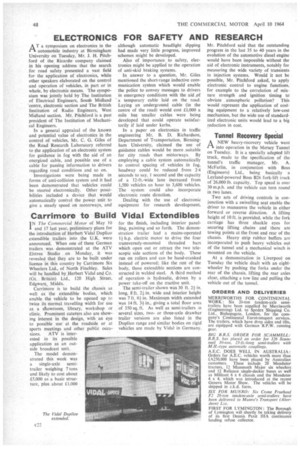ELECTRONICS FOR SAFETY AND RESEARCH
Page 50

If you've noticed an error in this article please click here to report it so we can fix it.
AT a symposium on electronics in the automobile industry at 'Birmingham University on Tuesday, Mr. J. H. Pitchford of the Ricardo company claimed in his opening address that the search for road safety presented a vast field for the application of electronics, while other speakers elaborated on the control and operation of vehicles, in part or in whole, by electronic means. The symposium was jointly held by The Institution of Electrical Engineers, South Midland 'centre, electronic section and The British Institution of Radio Engineers, West Midland section. Mr. Pitchford is a past president of The Institution of Mechanical Engineers.
In a general appraisal of the known and potential value of electronics in the control of vehicles, Mr. C. G. Giles of the Road Research Laboratory referred to the application of an electronic system for guidance in fog with the aid of an energized cable, and possible use of a cable for passing information to drivers regarding road conditions and so on.
Investigations were being made in forms of anti-collision system and it had been demonstrated that vehicles could be steered electronically. Other possibilities included a device that would automatically control the power unit to give a steady speed on motorways, and although automatic headlight dipping had made very little progress, improved schemes might be developed.
Also of importance to safety, electronics might be applied to the operation of anti-skid braking systems.
In answer to a question, Mr. Giles mentioned the short-range inductive communication system which would enable the police to convey messages to drivers in emergency conditions with the aid of a temporary cable laid on the road. Laying an underground cable (in the centre of the road) would cost £1,000 a mile but smaller cables were being developed that could operate satisfactorily if laid under kerbs.
In a paper on electronics in traffic engineering Mr. B. D. Richardson, Department of Transportation, Birmingham University, claimed the use of guidance cables would be more suitable for city roads than motorways. By employing a cable system automatically to control spacing of vehicles in fog, headway could be reduced from 2.4 seconds to say, 1 second and the capacity of a 12-11.-wide lane increased from 1,500 vehicles an hour to 3,600 vehicles. The system could also incorporate electronic route direction.
Dealing with the use of electronic equipment for research development. Mr. Pitchford said that the outstanding progress in the last 35 to 40 years in the evolution of the automotive diesel engine would have been impossible without the aid of electronic instruments, notably for measuring the wide variety of transients in injection systems. Would it not be possible, Mr. Pitchford asked, to apply electronic control to engine functions. for example to the correlation of mixture strength and ignition timing to 'obviate atmospheric pollution? This would represent the application of costing equipment to a relatively low-cost mechanism, but the wide use of standardized electronic units would lead to a big reduction in cost.
























































































































